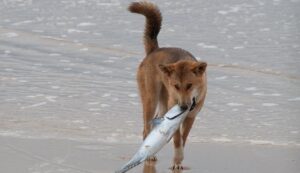Most pet owners indulge dogs by only eating dog food. Also, they see their dogs making puppy faces whenever they eat fish. This makes them wonder, Can dogs have fish?
The good news is that fish are safe for dogs in small quantities. But you must exercise some caution before letting your four-legged friend eat this meaty treat. For example, you need to make the fish free from bones and cook it, and the fish should not be high in mercury.
Unfortunately, fish can sometimes be a bad option for dogs, especially when they don’t eat it in the right way. This article will tell you how you can serve fish to your dog and make him reap the best benefits.
Can Dogs Have Fish?
Fish is always a favourite and safe food for dogs, but there are some exceptions. For example, you can feed short-lived fish to dogs, as they attract less mercury. Such as Arctic char, flounder, heating, salmon, catfish, etc. Longer-lived species, like sharks, albacore tuna fish, tilefish, etc., are not safe for dogs.
Feeding fish to your dog can offer him many benefits. Their main nutrients are protein and omega-3 fatty acids. These can develop dogs’ muscle health, skin health, coat health, etc. However, there are more nutrients present in fish; we will discuss that later.
Along with benefits, fish can pose health threats to dogs. For instance, certain fish contain high amounts of phosphorus, which may not be good for them. Besides, the oil present in the cooked fish can inflame dogs’ pancreas. This means eating too much fish can be hazardous for our paw friends.
What Types Of Fish Can Dogs Have?
Commercial dog foods include fish in their ingredients. But the fish found in them is not a random one. They have those fish that have a shorter life span. It is because short-lived fish don’t have the same levels of mercury, metals, and toxicity as long-lived fish. Anyway, here is the list of fish that can suit our canine friends.
Cod
Cod is a low-calorie and high-protein fish. It has ample amounts of B vitamins, selenium, and potassium. All its nutrients can improve your dog’s heart health, metabolism function, DNA protection, etc. However, the omega-3 fatty acids in cod are a bit lower than in other fish.
Haddock
Haddock is another nutritious fish with low mercury and low calories. It is rich in phosphorus, selenium, vitamin B3, vitamin B6, vitamin B12, and so on. These nutrients can promote dogs’ nerve health, red blood cells, bone health, teeth health, etc. Again, the high amounts of omega-3 fatty acids found in haddock will keep their hearts and skin healthy.
Salmon
Since salmon live a shorter life, they can hardly attract mercury and lead. Cooking this protein-enriched fish can provide selenium and omega-3 fatty acids to dogs. This can protect them from inflammation and make the heart, skin, and coat healthy.
Flounder
Flounder also has omega-3 fatty acids, like docosahexaenoic acid and eicosapentaenoic acid. Its nutrients include iron, choline, iodine, selenium, zinc, vitamin B12, and vitamin D. Besides, flounder doesn’t have histamine, which can cause allergic reactions in dogs.
Sardines
Sardines fall into the category of safe fish for dogs. Thanks to its loaded nutrients, like protein, calcium, vitamin B12, vitamin D, and omega-3 fatty acids (EPA, DHA, and ALA). With these nutrients, sardines can prevent dogs from developing diabetes and improve their bone health, heart health, and brain health.
Tilapia
Tilapia is a good source of protein and omega-3 fatty acids. Its additional nutrients are vitamin B12, vitamin D, niacin, choline, phosphorus, and selenium. This fish can aid in neurological function, metabolic activity, muscle growth, etc. in dogs.
Lobster
A small amount of lobster can be a great addition to your dog’s diet. It has zinc, iron, protein, and, of course, omega-3 fatty acids. Whether it is about having healthy bones, muscles, or immune systems, lobster puts a tick on all requirements.
Catfish
Catfish is mostly lean protein with low calories. It has vitamin B12 and omega-3 fatty acids that can improve the health of any dog.
What Types Of Fish Dogs Cannot Have?
Some fish can be red flags for dogs, especially if they are long-lived. A fish that lives longer means that he has attracted a lot of mercury, lead, metal, etc. in his entire life. These elements can harm not only humans but also our paw friends. Such types of fish are called mercury fish. Some of them are:
- Tilefish
- Swordfish
- Albacore tuna fish
- King mackerel
- Shark
Eating these fish can cause mercury poisoning in dogs. In such cases, the initial symptoms would be tremors, blindness, loss of coordination, convulsions, etc. If the mercury poisoning gets extreme, dogs can go through anorexia, depression, and paralysis.
Sometimes safe fish can be hazardous for dogs, especially when you serve them raw. Raw fish carries parasites and bacteria, like salmonella and listeria. These can lead to vomiting, bloody diarrhoea, weakness, seizures, difficulty breathing, etc.
How To Offer Fish To Dogs?
Whenever you consider adding fish to your dog’s meal, make sure it is a safe one. Then take a part of the fish and cook it without any ingredients. You can boil it, steam it, bake it, or grill it. There is no problem if you include the fish’s skin too; cooked fish’s skin is not harmful.
The fish that you are offering to your dog should be plain and have no bones. As usual, fish will have bones; you just need to remove them and offer the meat to him in bite-sized pieces.
How Much Fish Can Dogs Have?
Fish and meat are the favourite foods for dogs. Perhaps your dog will keep eating the fish if you offer him one. But that can result in multiple side effects because dogs can only reap the benefits of fish if they eat it in the right amount.
Anyway, extra-small breeds, like Chihuahuas, can have ½ teaspoon of the fish. Again, small dogs like miniature Australian Shepherds can eat one teaspoon of fish. Medium dogs, like Australian Cattle Dogs, can eat up to two teaspoons, and large dogs, like Labrador Retrievers, can eat up to three teaspoons. Lastly, extra-large dogs, like Bernese Mountain Dogs, should not eat more than four teaspoons of fish.
Frequently Asked Questions: Can Dogs Have Fish?
Can dogs have fish every day?
Dog foods contain fish as a primary ingredient. Eating fish can make dogs ingest too much phosphorus, oil, etc. Hence, fish should be an occasional treat for dogs, not a regular treat.
Is seafood safe for dogs?
All seafood is not safe for dogs. For example, sellfish, tilefish, etc. are not safe for them. Again, seafood, like salmon, sardines, shrimp, etc., is safe for dogs. However, all seafood should be cooked; raw seafood or any raw fish can pose health risks.
How should you cook fish for dogs?
Before cooking fish, heat your oven to 350°F. Then place the fish in the oven and let it bake for 15 to 20 minutes. Don’t forget to wash the fish thoroughly to remove potential bacteria and parasites.
Final Verdict
Since all fish are not good for dogs, we may think, Can dogs have fish? The answer is yes; you just need to include the safe fish, i.e., fish that have no mercury, lead, or toxins. Besides, you should cook the fish first and remove its bones.
You can use any form to cook fish for your dog but don’t fry it. This can cause vomiting, diarrhoea, stomach upset, and even pancreatitis in dogs. Also, don’t offer garlic, onion, butter, salt, spices, or seasonings on the fish.



